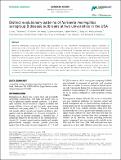Files in this item
Distinct evolutionary patterns of Neisseria meningitidis serogroup B disease outbreaks at two universities in the USA
Item metadata
| dc.contributor.author | Hao, Li | |
| dc.contributor.author | Holden, Matthew T. G. | |
| dc.contributor.author | Wang, Xin | |
| dc.contributor.author | Andrew, Lubomira | |
| dc.contributor.author | Wellnitz, Sabine | |
| dc.contributor.author | Hu, Fang | |
| dc.contributor.author | Whaley, Melissa | |
| dc.contributor.author | Sammons, Scott | |
| dc.contributor.author | Knipe, Kristen | |
| dc.contributor.author | Frace, Mike | |
| dc.contributor.author | McNamara, Lucy A | |
| dc.contributor.author | Liberator, Paul | |
| dc.contributor.author | Anderson, Annaliesa S | |
| dc.date.accessioned | 2018-04-18T08:30:13Z | |
| dc.date.available | 2018-04-18T08:30:13Z | |
| dc.date.issued | 2018-04 | |
| dc.identifier | 252839418 | |
| dc.identifier | 1ef1abf1-374e-4496-879d-39521cb73462 | |
| dc.identifier | 29616896 | |
| dc.identifier | 85058468823 | |
| dc.identifier | 000431156200001 | |
| dc.identifier.citation | Hao , L , Holden , M T G , Wang , X , Andrew , L , Wellnitz , S , Hu , F , Whaley , M , Sammons , S , Knipe , K , Frace , M , McNamara , L A , Liberator , P & Anderson , A S 2018 , ' Distinct evolutionary patterns of Neisseria meningitidis serogroup B disease outbreaks at two universities in the USA ' , Microbial Genomics , vol. 4 , no. 4 , e000155 . https://doi.org/10.1099/mgen.0.000155 | en |
| dc.identifier.issn | 2057-5858 | |
| dc.identifier.other | ORCID: /0000-0002-4958-2166/work/60196419 | |
| dc.identifier.uri | https://hdl.handle.net/10023/13154 | |
| dc.description | L. H., L. A., S. W., P. L. and A. S. A. are current employees of Pfizer, and this work was funded by Pfizer Inc. | en |
| dc.description.abstract | Neisseria meningitidis serogroup B (MnB) was responsible for two independent meningococcal disease outbreaks at universities in the USA during 2013. The first at University A in New Jersey included nine confirmed cases reported between March 2013 and March 2014. The second outbreak occurred at University B in California, with four confirmed cases during November 2013. The public health response to these outbreaks included the approval and deployment of a serogroup B meningococcal vaccine that was not yet licensed in the USA. This study investigated the use of whole-genome sequencing(WGS) to examine the genetic profile of the disease-causing outbreak isolates at each university. Comparative WGS revealed differences in evolutionary patterns between the two disease outbreaks. The University A outbreak isolates were very closely related, with differences primarily attributed to single nucleotide polymorphisms/insertion-deletion (SNP/indel) events. In contrast, the University B outbreak isolates segregated into two phylogenetic clades, differing in large part due to recombination events covering extensive regions (>30 kb) of the genome including virulence factors. This high-resolution comparison of two meningococcal disease outbreaks further demonstrates the genetic complexity of meningococcal bacteria as related to evolution and disease virulence. | |
| dc.format.extent | 10 | |
| dc.format.extent | 932814 | |
| dc.language.iso | eng | |
| dc.relation.ispartof | Microbial Genomics | en |
| dc.subject | Serogroup B Neisseria meningitidis | en |
| dc.subject | Disease outbreak | en |
| dc.subject | Multi-locus sequence typing (MLST) | en |
| dc.subject | Whole genome sequence (WGS) | en |
| dc.subject | Single nucleotide polymorphism (SNP) | en |
| dc.subject | Vaccine | en |
| dc.subject | QR355 Virology | en |
| dc.subject | RA0421 Public health. Hygiene. Preventive Medicine | en |
| dc.subject | DAS | en |
| dc.subject | SDG 3 - Good Health and Well-being | en |
| dc.subject.lcc | QR355 | en |
| dc.subject.lcc | RA0421 | en |
| dc.title | Distinct evolutionary patterns of Neisseria meningitidis serogroup B disease outbreaks at two universities in the USA | en |
| dc.type | Journal article | en |
| dc.contributor.institution | University of St Andrews. School of Medicine | en |
| dc.contributor.institution | University of St Andrews. Infection and Global Health Division | en |
| dc.contributor.institution | University of St Andrews. Infection Group | en |
| dc.contributor.institution | University of St Andrews. Biomedical Sciences Research Complex | en |
| dc.identifier.doi | https://doi.org/10.1099/mgen.0.000155 | |
| dc.description.status | Peer reviewed | en |
This item appears in the following Collection(s)
Items in the St Andrews Research Repository are protected by copyright, with all rights reserved, unless otherwise indicated.

